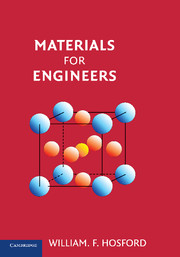Book contents
- Frontmatter
- Contents
- Preface
- 1 Introduction
- 2 Phases
- 3 Diffusion
- 4 Mechanical Behavior
- 5 Mechanical Failure
- 6 Annealing
- 7 Iron and Steel
- 8 Nonferrous Metals
- 9 Casting and Welding
- 10 Solid Shaping
- 11 Polymers
- 12 Polymer Processing
- 13 Glasses
- 14 Crystalline Ceramics
- 15 Powder Processing
- 16 Pottery and Concrete
- 17 Composites
- 18 Carbon
- 19 Fibers, Foams, and Porous Materials
- 20 Electrical Properties
- 21 Optical and Thermal Properties
- 22 Magnetic Materials
- 23 Corrosion
- 24 Modern Manufacturing Techniques, Surface Treatments, and Recycling
- APPENDIX 1 Wood
- APPENDIX 2 Miller Indices for Planes and Directions
- APPENDIX 3 X-ray Diffraction
- APPENDIX 4 Surfaces
- APPENDIX 5 Dislocations
- APPENDIX 6 Avrami Kinetics
- APPENDIX 7 Organic Chemistry
- APPENDIX 8 Average Molecular Weight
- APPENDIX 9 Bond Geometry in Compounds
- APPENDIX 10 Weibull Analysis
- Index
- Conversions
13 - Glasses
Published online by Cambridge University Press: 05 June 2012
- Frontmatter
- Contents
- Preface
- 1 Introduction
- 2 Phases
- 3 Diffusion
- 4 Mechanical Behavior
- 5 Mechanical Failure
- 6 Annealing
- 7 Iron and Steel
- 8 Nonferrous Metals
- 9 Casting and Welding
- 10 Solid Shaping
- 11 Polymers
- 12 Polymer Processing
- 13 Glasses
- 14 Crystalline Ceramics
- 15 Powder Processing
- 16 Pottery and Concrete
- 17 Composites
- 18 Carbon
- 19 Fibers, Foams, and Porous Materials
- 20 Electrical Properties
- 21 Optical and Thermal Properties
- 22 Magnetic Materials
- 23 Corrosion
- 24 Modern Manufacturing Techniques, Surface Treatments, and Recycling
- APPENDIX 1 Wood
- APPENDIX 2 Miller Indices for Planes and Directions
- APPENDIX 3 X-ray Diffraction
- APPENDIX 4 Surfaces
- APPENDIX 5 Dislocations
- APPENDIX 6 Avrami Kinetics
- APPENDIX 7 Organic Chemistry
- APPENDIX 8 Average Molecular Weight
- APPENDIX 9 Bond Geometry in Compounds
- APPENDIX 10 Weibull Analysis
- Index
- Conversions
Summary
Glasses are amorphous so they have no long-range order and no symmetry. There is, however, a great deal of short-range order. If crystallization is prevented during cooling, an amorphous glass will form with short-range order inherited from the liquid. The critical cooling rate to prevent crystallization varies greatly from one material to another. Silicate glasses cannot crystallize unless the cooling rates are extremely slow. On the other hand, extremely rapid cooling is required to prevent crystallization of metals.
Structure of Silicate Glasses
The basic structural units of silicate glasses are tetrahedra with Si4+ ions in the center bonded covalently to O2− ions at each corner. In pure silica all corner oxygen ions are shared by two tetrahedra (Figure 13.1). The result is a covalently bonded glass with a very high viscosity at elevated temperatures.
The compositions of typical commercial glasses are quite complex. Soda-lime glasses may contain 72% SiO2, 14% Na2O, 11% CaO, and 3% MgO. The Na+, Ca2+, and Mg2+ ions are bonded ionically to some of the corner O2− ions (Figure 13.2). With these alkali and alkaline earth oxides, not all of the oxygen ions are covalently bonded to two tetrahedra. This lowers the viscosity at high temperatures.
- Type
- Chapter
- Information
- Materials for Engineers , pp. 130 - 141Publisher: Cambridge University PressPrint publication year: 2008



